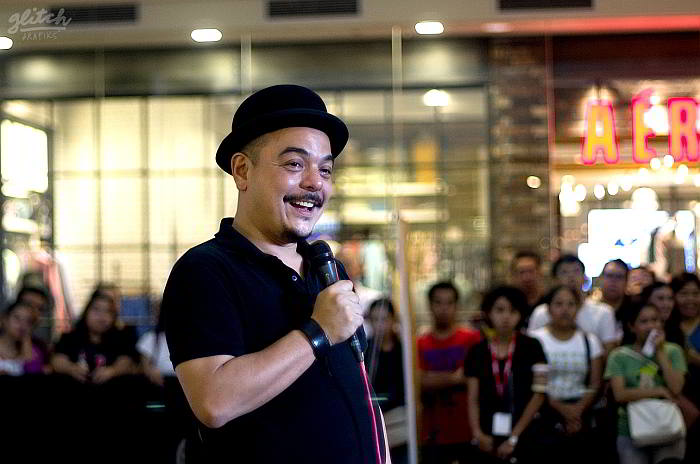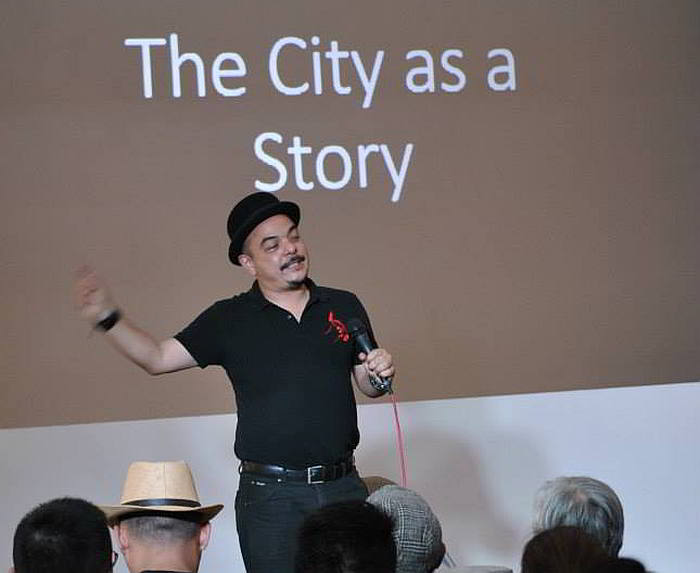Imagine a book without pictures; the past, painstakingly detailed and accurate. Performance artist Carlos Celdran cannot picture this.
What started off as a “selfish desire” to find his medium of expression is now a passion— a calling that sets him apart from other tour guides in Manila. His take on heritage and the way he recounts history has drawn many to join his Walk This Way Tour, covering the stone paths and walls of Intramuros, the old streets of Ermita and Malate, and the roads around the Cultural Center of the Philippines complex.
His stories go beyond what is written in the brochures—he peppers them with opinions, rumors, controversies. He engages tour participants through songs, costumes of the times, props, altogether taking away the serious mood whenever we discuss history.
His performance art is not just part of his living, but also his advocacy.
Carlos made headlines in 2010 when he went inside the Manila Cathedral during a Mass celebrated by Manila Archbishop Gaudencio Cardinal Rosales and the Papal Nuncio Archbishop Edward Adams, dressed as Rizal holding a placard with the word “Damaso,” with reference to the infamous Spanish friar in Rizal’s book “Noli Me Tangere.”
Though it got him a case for “offending religious feelings,” he was able to get his message across on both political and literary points.
We caught Carlos at the Cebu Literary Festival and asked him about the journey—this unusual take on history.

Carlos Celdran during the Cebu Literary Festival. (CDN PHOTO)
Are you an artist, an activist, or a tour guide?
I’m a performance artist—with Manila and Intramuros as my canvass. The paint are my performances. The urban advocacy is the result.
How did you come up with the idea of merging performance art and history in your tours?
It happened by accident. Your mom and dad always tell you to try and try until you die, right? When something fails, you get back up and do it again, you get back up and do it again… The performances I’ve been doing in Intramuros for 15 years now.
And you have a long queue of participants!
I can’t complain. I have been paying taxes for it, too much if I may say, given that the kalesa drivers are not VATable! So that’s how I ended up here. It is multi-media; it is performance. I would love to blur the lines distinguishing art practices, and I really hope that what I do blurs the lines of writing, performance, and painting.
Can you give us more details to that journey? You mentioned this happening by accident.
The performance stemmed from a need of a job… I became a tour guide. Before that, I was a docent, or someone who gives tours in art institutions. From there I went on to touring the city. Since I have a background in fine arts as well as performance art, every day I’d add a hat, put on some music, change my costume, bring a picture… and doing it for 15 years, I finally got to where it is today.
I am just basically repeating what I’ve done… which is how I mastered the craft, I guess.
Do you research on your topics, or just go with what’s generally known?
Oh, yeah! I have 15 years of making mistakes, 15 years of being corrected by people. It’s not easy, but I don’t give up.
How much of Rizal have you read?
I read “Rizal Without the Overcoat” (a book by historian Ambeth Ocampo) to the end. I read his works in the academe. I read “Noli Me Tangere” and “El FIlibusterismo” as a kid, and the comic version to make it easier. It also had to be the English version to be easier for me! It’s not really his writings that inspire me—it is who Rizal is that inspires me.
Who is Rizal to you?
The ultimate Filipino.
From a history book standpoint, is your bias toward Renato Constantino or Teodoro Agoncillo?
Can I say neither? Luis Francia! All of them are good, but Francia just brings that modern twist. Both Constantino and Agoncillo are valid… there’s no such thing as one point of view in history. All these historians are being analyzed in their own way. I’ve read enough about it to come up with my own point of view. We shouldn’t be afraid to come up with our own opinions about history.
From your Intramuros tour how did you get to Imelda Marcos?
It’s all a progression. In Manila, you clearly see it. Intramuros is the Spanish and Chinese period. Malate and Ermita is the American period. Then the CCP (Cultural Center of the Philippines) Complex is the Imelda period. Those are the three major periods of economic wealth where we had some kind of architecture that is somehow emblematic.
Your performances on Imelda tackle what has been written and the rumors the come with it. Did you ever have a Marcos in your audience?
Imee Marcos has watched my tour as well as her daughter-in-law, Lisa. It freaked me out a bit. They had no commentary… they didn’t tell me what they thought about it. I think that the Marcoses have a sense of humor. Whatever they heard from me, they must have heard something worse from someone else who is probably closer to them. I’m a stranger so why would they care what I think? I also think that they are quite realistic with their position in Philippine history. They know it’s not going to be easy if they want to overcome it.
Paint us a picture of your tour.
It’s a play every day in the heat of the sun where you are the director, the performer, the handler, the costume mistress, everything! As I have said, I have been doing it for 15 years. It is like doing yoga—it’s a craft. From that moment when I play the National Anthem until I close my book and drop it on the floor… everything in there is a zone. Things have to go perfectly, things can be broken, there is an energy level that you reach and drop. It’s a play every day. And with it, I find centered-wisdom.
Do you get flak for “making fun of history”?
It’s fine because I am not a historian! I am just a lucky guy who has read enough! (Laughs) People mistake me for being one. Don’t kill my spirit, because you are going to make history so precious that no one wants to study it. You have to make history relevant for the times and so easy to digest in order for it to be alive in each one of us. By keeping it precious, overly accurate, too much caught up in the details… who would want to touch that?
Did your experience in Dubai where they made you modify your performance traumatize you in any way?
Yeah … no! It’s just never go to Dubai again! (Laughs) That is not a world I want to live in.
Let’s talk about your activism. What was running in your head when you decided to appear before the Archbishop of Manila and the Papal Nuncio in Mass, dressed as Rizal holding the “Damaso” placard?
I don’t know how or why I got there. I’m only glad that I used arts and culture, I used a costume, I used a literary reference. If I wore a T-shirt that says “Pass the RH Bill Now,” I would have been taken differently. But by going there in a Rizal outfit with the word “Damaso,” instantly 95 million Filipinos knew what I was talking about. They knew the references, they knew the complexity. Let’s give Filipinos credit! As 95 million people, we were able to create a complex thought process that had to do with our literature and performance art! If we were not that of an artistic people, it would not have gone that way. I would have been jailed, stoned and beheaded in other cultures. If we want to change the world, always use arts and culture. You cannot force Filipinos to change, but you can inspire them to change.
If you are not performing or protesting, what do you do?
Facebook, sadly… and I’m trying to get off it! (Laughs) I like rivers more than beaches. I’m a Filipino who doesn’t like beaches—isn’t that bizarre? I like rivers and tampisaw! I like mountains. I like hiking. Biking all around Manila is also one of my hobbies.


